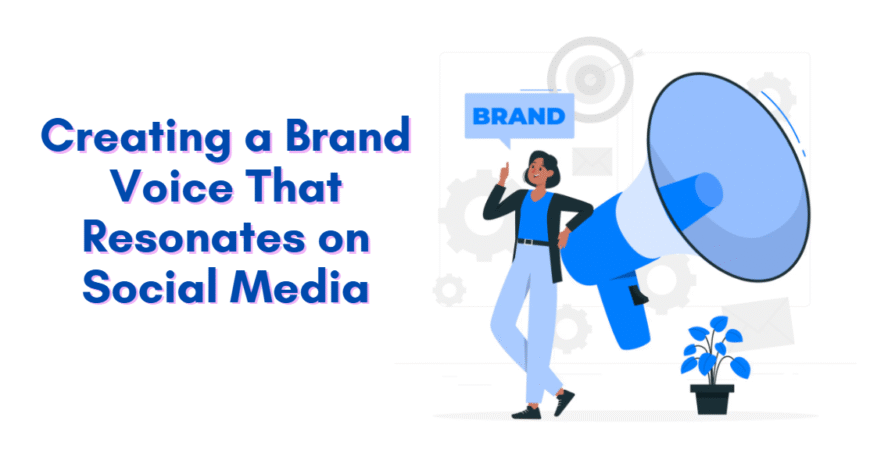
Table of Contents
- Introduction
- What is Brand Voice?
- The Psychology Behind a Resonating Brand Voice
- Elements That Shape Your Brand Voice
- Types of Brand Voices That Work on Social Media
- How to Create Your Unique Brand Voice
- Brand Voice Guidelines for Social Media Platforms
- Common Mistakes to Avoid
- Tools and Templates to Maintain Brand Voice
- Measuring the Impact of Your Brand Voice
- Real Examples of Brands with Distinct Social Media Voices
- How to Train Your Team on Brand Voice
- Keeping Your Brand Voice Fresh
- Conclusion
- FAQs
Introduction
Scroll through your feed, and you’ll notice something—some brands just get it. They sound human, they make you laugh or think, and more importantly, you remember them. That’s the magic of a strong brand voice. In today’s chaotic, scroll-happy digital world, your brand voice isn’t just a tone—it’s your online personality. And when it resonates, it builds trust, loyalty, and influence.
What is Brand Voice?
Defining Brand Voice vs. Tone
Let’s break it down: brand voice is your brand’s personality expressed in writing. It’s how your brand would “speak” if it were a person. Tone, on the other hand, adapts depending on the context (angry tweet? Calm reply? Friendly DM?).
For example, a sarcastic brand voice can still take on a serious tone in response to a customer complaint without completely ditching its core personality.
Why Your Brand Voice Is Not Just a Marketing Gimmick
A consistent, recognizable brand voice helps your audience feel like they know you. And people trust what they know. Think of it as the difference between chatting with an old friend vs. a random stranger. Guess who you’re more likely to buy from?
The Psychology Behind a Resonating Brand Voice
The Power of Emotional Connection
Humans make decisions based on emotion, then justify them with logic. A great brand voice taps into that emotion—whether it’s joy, nostalgia, curiosity, or belonging.
The Role of Consistency in Consumer Trust
When your tone shifts wildly across platforms or posts, it confuses people. But when your voice stays steady, it creates a safe, familiar experience. Consistency builds reliability—and reliability builds trust.
Elements That Shape Your Brand Voice
- Your Brand’s Core Values: Your voice should reflect what you stand for. Are you rebellious? Thoughtful? Earth-conscious? Those values shape your tone.
- Your Target Audience Persona: Are you speaking to Gen Z, C-suite execs, or pet parents? Knowing your audience determines if your voice should be cheeky, informative, or inspirational.
- Industry and Market Positioning: A B2B cybersecurity firm and a B2C skincare brand won’t sound the same. Nor should they. Your market niche helps refine what not to sound like too.
Types of Brand Voices That Work on Social Media
The Witty and Playful Brand
This type of voice is fun, clever, and often a little cheeky. It thrives on humor, memes, and cultural references. Brands that embrace a witty tone understand the internet’s love for entertainment and leverage that to drive engagement. The playful voice often leans into current trends, slang, and even occasional sarcasm to stay relatable and meme-worthy. Humor is shareable. A funny post can quickly go viral, bringing massive attention to your brand without a hefty ad spend. It makes your brand feel human, approachable, and fun to follow. B2C brands, food and beverage, fashion, tech, entertainment.
Wendy’s has practically written the book on playful social media. From roasting competitors to engaging with pop culture, their snappy tweets have made them a household name—not just for burgers, but for banter. Their bold, unfiltered tone breaks the monotony and makes fans feel like they’re in on a joke.
The Empathetic and Supportive Brand
The Bold and Fearless Brand
A bold brand voice is powerful, unapologetic, and deeply rooted in purpose. It’s confident and often challenges the status quo. These brands don’t tiptoe around their beliefs; instead, they amplify them loudly and proudly. This voice grabs attention, provokes thought, and appeals to emotionally-driven audiences who want to align with brands that stand for something. It encourages people to rally behind your cause, turning customers into advocates. Best suited for: Sports, fitness, activism-based, lifestyle, and purpose-driven brands.
Nike’s brand voice consistently exudes confidence and inspiration. Whether it’s through campaigns like “Just Do It” or their support for social issues, Nike speaks to the inner athlete in all of us. Their posts are short, powerful, and always align with their core value: empowerment.
The Empathetic and Supportive Brand
Empathetic brands prioritize emotional connection over promotional push. They actively listen to their audience, respond with compassion, and communicate in a way that feels deeply human. Their content is often centered around encouragement, inclusion, self-love, and wellbeing. In a world overloaded with sales and noise, empathy cuts through by making people feel seen. Supportive brands cultivate community and foster loyalty by showing they genuinely care about their audience’s lives, not just their wallets. Best suited for: Wellness, skincare, education, nonprofit, mental health, parenting.
Dove’s tone is gentle, uplifting, and rooted in authenticity. Their campaigns like “Real Beauty” aim to dismantle unrealistic standards and promote body positivity. They consistently use inclusive language, real imagery, and compassionate messaging that builds trust with a wide, diverse audience.
The Professional and Authoritative Brand
This voice is confident, knowledgeable, and clear. It avoids jargon without dumbing things down. Brands using this tone aim to educate, inform, and build credibility—without sounding robotic. Think thought leaders rather than marketers. People trust experts. A professional voice adds credibility to your brand, especially in industries where reliability, precision, and security are non-negotiable. It positions your brand as a go-to resource in your niche. Best suited for: B2B, finance, SaaS, legal, consulting, cybersecurity, tech.
IBM is the gold standard when it comes to authoritative branding. Their content on AI, data, and digital transformation is always presented in a calm, intelligent, and highly informative tone. Yet, it’s still digestible and relevant—even when discussing complex innovations.

Brand Voice Guidelines for Social Media Platforms
Instagram – Visual + Conversational
Short captions, emojis, and behind-the-scenes language thrive here. Your voice should feel like a friendly DM.
Twitter – Short, Sharp, and Snappy
You’ve got 280 characters. Be witty, punchy, and quick to the point.
LinkedIn – Professional, Yet Relatable
Even if B2B, don’t be robotic. Thought leadership posts can still sound human.
TikTok – Trendy, Casual, and Fun
Follow trends, slang, and sounds. Your voice should blend in with the culture while staying true to your core.
Common Mistakes to Avoid
Inconsistency Across Channels
Your Twitter shouldn’t sound like a different brand from your Instagram. Create channel-specific guidelines to avoid this.
Overcomplicating the Message
Simple sells. Don’t bury your voice under complex words or corporate-speak.
Ignoring Audience Feedback
Your audience tells you what’s working through likes, comments, DMs, and shares. Listen and adapt.
Tools and Templates to Maintain Brand Voice
Style Guides
Create a PDF or Notion doc outlining your brand’s tone, vocabulary, emoji usage, and “don’ts.”
Content Calendars
Plan your messaging ahead. It helps maintain tone consistency across campaigns.
AI + Human Copywriting Collaboration
Tools like Grammarly, Jasper, or even ChatGPT can help, but always add your human touch.
Measuring the Impact of Your Brand Voice
Engagement Metrics
Track likes, shares, saves, and comments to see what content hits home.
Sentiment Analysis
Tools like Brandwatch or Sprout Social help you monitor how people feel about your messaging.
Conversion Rates from Social Posts
Do your posts lead to clicks, signups, or sales? A resonant voice can directly impact conversions.
Real Examples of Brands with Distinct Social Media Voices
Wendy’s (Playful Roasting)
Unapologetically bold, and they roast their competition to the delight of Twitter fans.
Dove (Body Positivity and Empathy)
Soft-spoken and heartfelt, reflecting their mission to build self-esteem.
Mailchimp (Helpful, Friendly, Clear)
They simplify tech with a warm, approachable voice, especially in product updates.
Conclusion
In a sea of content, your brand voice is your beacon. It’s how people recognize, trust, and connect with you. Build it with care, maintain it with consistency, and most importantly—make it human. Because at the end of the day, people don’t connect with logos. They connect with personalities.
FAQs
Q1: How do I know if my brand voice is resonating?
A: Check engagement metrics, sentiment analysis, and feedback. If your audience starts mimicking your tone in comments, you’re doing something right.
Q2: Can a small business have a strong brand voice?
A: Absolutely! In fact, small businesses often have the advantage of sounding more personal and relatable.
Q3: Should my brand voice be the same across all platforms?
A: Your core voice should remain the same, but tone can adapt per platform. Think of it like wearing different outfits to different events—you’re still you.
Q4: What if my team members post in different styles?
A: Create a centralized style guide and train everyone. Use tools like Grammarly Teams or Notion for collaborative content review.
Q5: Is humor always effective in brand voice?
A: Not always. Humor works great for some brands but can feel forced or inappropriate for others. Stick to what feels authentic to your brand values.




